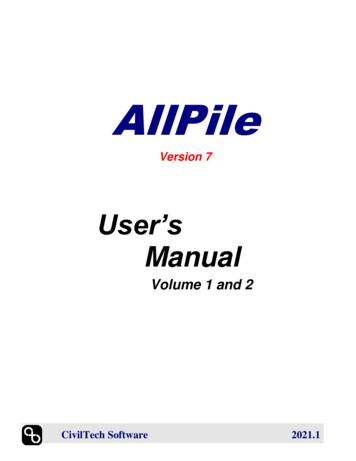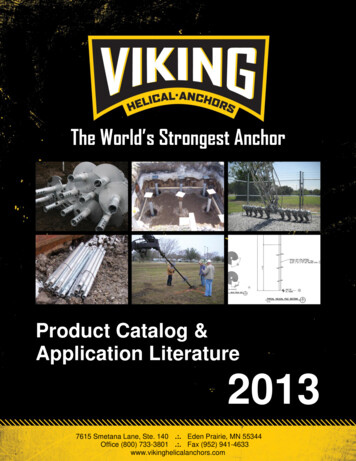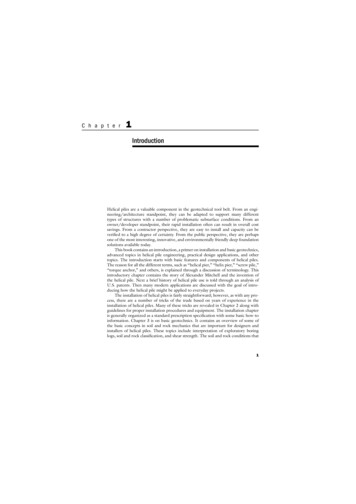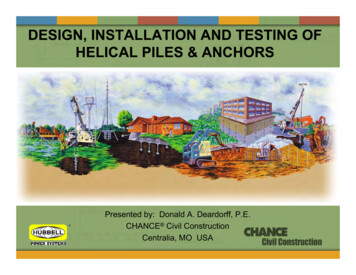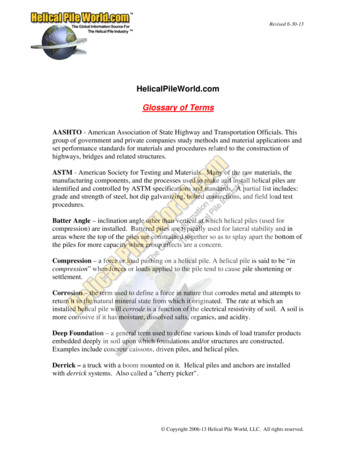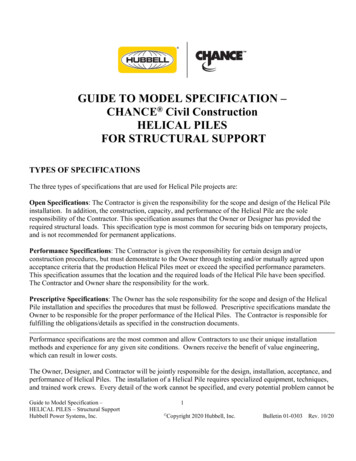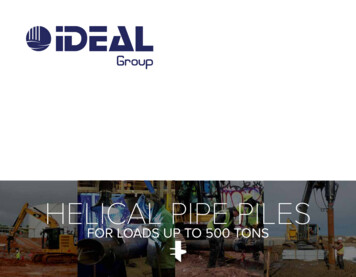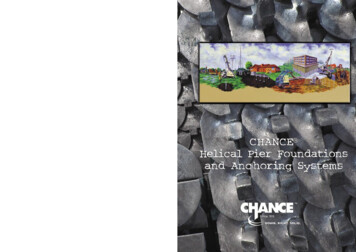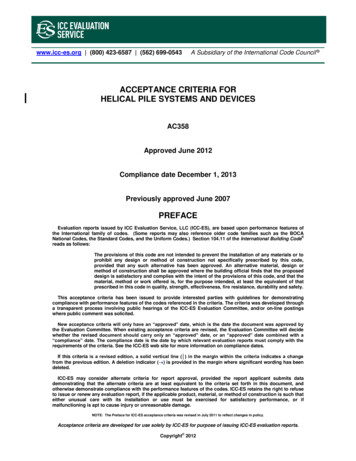
Transcription
www.icc-es.org (800) 423-6587 (562) 699-0543A Subsidiary of the International Code Council ACCEPTANCE CRITERIA FORHELICAL PILE SYSTEMS AND DEVICESAC358Approved June 2012Compliance date December 1, 2013Previously approved June 2007PREFACEEvaluation reports issued by ICC Evaluation Service, LLC (ICC-ES), are based upon performance features ofthe International family of codes. (Some reports may also reference older code families such as the BOCANational Codes, the Standard Codes, and the Uniform Codes.) Section 104.11 of the International Building Code reads as follows:The provisions of this code are not intended to prevent the installation of any materials or toprohibit any design or method of construction not specifically prescribed by this code,provided that any such alternative has been approved. An alternative material, design ormethod of construction shall be approved where the building official finds that the proposeddesign is satisfactory and complies with the intent of the provisions of this code, and that thematerial, method or work offered is, for the purpose intended, at least the equivalent of thatprescribed in this code in quality, strength, effectiveness, fire resistance, durability and safety.This acceptance criteria has been issued to provide interested parties with guidelines for demonstratingcompliance with performance features of the codes referenced in the criteria. The criteria was developed througha transparent process involving public hearings of the ICC-ES Evaluation Committee, and/or on-line postingswhere public comment was solicited.New acceptance criteria will only have an “approved” date, which is the date the document was approved bythe Evaluation Committee. When existing acceptance criteria are revised, the Evaluation Committee will decidewhether the revised document should carry only an “approved” date, or an “approved” date combined with a“compliance” date. The compliance date is the date by which relevant evaluation reports must comply with therequirements of the criteria. See the ICC-ES web site for more information on compliance dates.If this criteria is a revised edition, a solid vertical line ( ) in the margin within the criteria indicates a changefrom the previous edition. A deletion indicator ( ) is provided in the margin where significant wording has beendeleted.ICC-ES may consider alternate criteria for report approval, provided the report applicant submits datademonstrating that the alternate criteria are at least equivalent to the criteria set forth in this document, andotherwise demonstrate compliance with the performance features of the codes. ICC-ES retains the right to refuseto issue or renew any evaluation report, if the applicable product, material, or method of construction is such thateither unusual care with its installation or use must be exercised for satisfactory performance, or ifmalfunctioning is apt to cause injury or unreasonable damage.NOTE: The Preface for ICC-ES acceptance criteria was revised in July 2011 to reflect changes in policy.Acceptance criteria are developed for use solely by ICC-ES for purpose of issuing ICC-ES evaluation reports.Copyright 2012
ACCEPTANCE CRITERIA FORHELICAL PILE SYSTEMS AND DEVICES1.0INTRODUCTION1.1 Purpose: The purpose of this acceptance criteriais to establish requirements for helical pile systems andhelical pile devices to be recognized in ICC EvaluationService, LLC (ICC-ES), evaluation reports under the 2012, 2009 and 2006 International Building Code (IBC) and the1997 Uniform Building Code (UBC). The basis forrecognition is IBC Section 1810.3.3.1.9, 2006 IBC Section104.11 and UBC Section 104.2.8.The reason for the development of this acceptancecriteria is to supplement general requirements for helicalpiles in the IBC and UBC to permit evaluation of helicalpile systems and devices.1.2 Scope: This criteria provides methods to establishthe allowable load and deformation capacities of helicalpile systems and devices used to resist axial compression,axial tension or lateral loads. This criteria applies to helicalpile systems and devices as defined in IBC Section 1802and Section 1.4 and includes provisions for determiningsoil embedment and soil capacity.1.3.9 ASTM A123-02, Standard Specification forZinc (Hot-Dip Galvanized) Coatings on Iron and SteelProducts, ASTM International.1.3.10 ASTM A153-05, Standard Specification forZinc Coating (Hot-Dip) on Iron and Steel Hardware, ASTMInternational.1.3.11 ASTM B633-07 Standard Specification forElectro deposited Coatings of Zinc on Iron and Steel,ASTM International.1.3.12 ASTM B695-04 Standard Specification forCoatings of Zinc Mechanically Deposited on Iron andSteel, ASTM International.1.3.13 ASTM C31-08b, Standard Practice for Makingand Curing Concrete Test Specimens in the Field, ASTMInternational.1.3.14 ASTM C39-03, Standard Test Method forCompressive Strength of Cylindrical Concrete Specimens,ASTM International.This criteria is limited to helical pile systems and devicesused under the following conditions:1.3.15 ASTM D1143-07e1, Standard Test Method forPiles Under Static Axial Compressive Load, ASTMInternational.1.2.1 Support of structures in IBC Seismic DesignCategories A, B, or C, or UBC Seismic Zones 0, 1 or 2,only.1.3.16 ASTM D1586-99, Standard Test Method forPenetration Test and Split-Barrel Sampling of Soils, ASTMInternational.1.2.2 Exposure conditions to soil that are notindicative of potential pile deterioration or corrosionsituations as defined by the following: (1) soil resistivityless than 1,000 ohm-cm; (2) soil pH less than 5.5; (3) soilswith high organic content; (4) soil sulfate concentrationsgreater than 1,000 ppm; (5) soils located in landfills, or (6)soil containing mine waste.1.3.17 ASTM D3689-07, Standard Test Method forIndividual Piles under Static Axial Tensile Load, ASTMInternational.1.2.3 Helical products manufactured from carbonsteel, with optional zinc or powder coatings.1.3.18 ASTM D3966-90(1995), Standard Test Methodfor Piles under Lateral Loads, ASTM International.1.3.19 ICC-ES Acceptance Criteria for CorrosionProtection of Steel Foundation Systems Using Polymer(EAA) Coatings (AC228).1.3 Codes and Referenced Standards: Wherestandards are referenced in this criteria, these standardsshall be applied consistently with the code (IBC, and UBC)upon which compliance is based in accordance with Table1.1.4 Definitions: Terminology herein is based on theGlossary of the IBC, AISC and the following definitions:1.3.1 2012, 2009, and 2006 International Building Code (IBC), International Code Council1.4.2 Helical Pile System: A factory-manufacturedsteel pile designed to resist axial compression, axialtension, and/or lateral loads from structures, consisting ofa helical pile having a central shaft with one or morehelical-shaped bearing plates, extension shafts, couplingsand a bracket that allow for attachment to structures. Thepiles are screwed into the ground by application of torsionand extended until a desired depth or a suitable soil orbedrock bearing stratum is reached.1.3.21997 Uniform Building Code (UBC) 1.3.3 ICC-ES Acceptance Criteria for InspectionAgencies (AC304).1.3.4 ANSI/AF&PANDS,NationalDesignSpecification for Wood Construction (NDS), AmericanForest & Paper Association.1.3.5 ACI 318, Building Code Requirements forStructural Concrete, American Concrete Institute.1.3.6 AISC 360, Specification for Structural SteelBuildings, American Institute of Steel Construction.1.3.7 ANSI/ASME Standard B18.2.1-1996, Squareand Hex Bolts and Screws, Inch Series, American Societyof Mechanical Engineers.1.3.8 ANSI/AWS D1.1/D1.1M, Structural WeldingCode—Steel (AWS D1.1/D1.1M), American WeldingSociety.1.4.1 Angle Bracket: A side load bracket withhorizontal bearing plate extending below and supporting aconcrete foundation.1.4.3 Helical Pile Device: For purposes of thiscriteria, a helical pile device is any part or component of ahelical pile system.1.4.4 Lateral Resistance: Capacity of a helical pilesystem or device to resist forces acting in a direction thatis perpendicular to the longitudinal direction of the shaft.1.4.5 ConventionalDesign:Methodsfordetermining design capacities of the helical pile systemthat are prescribed by and strictly in accordance withstandards and codes referenced in Section 1.3.
ACCEPTANCE CRITERIA FOR HELICAL PILE SYSTEMS AND DEVICES (AC358)1.4.6 Special Analysis: Methods for determiningdesign capacities of the helical pile system thatincorporate finite element modeling, discrete elementmodeling, strain compatibility, or other conventionalanalytical/numerical techniques. Computer softwaredeveloped for the analysis of laterally loaded helical piles,which incorporate methods of analysis considering thenonlinear interaction of the shaft with soil, is an example ofspecial analysis.2.0axial tension, or lateral loads, or a combination of theseloads. The required capacities shall be evaluated byconsidering four primary structural elements of the helicalpile system as shown in Figures 1 through 4. Theseelements are described as Bracket Capacity (P1), ShaftCapacity (P2), Helix Capacity (P3), and Soil Capacity (P4).The allowable capacity of a helical pile system or deviceshall be the lowest value of P1, P2, P3, and P4, from eachapplication illustrated in Figures 1 through 4. Forevaluation of helical pile devices subject to combinedlateral loads and axial compression or axial tension, theallowable lateral capacity and allowable axial capacityshall be determined and reported separately. Theallowable strength under combined load conditions shallbe determined using the interaction equation provided inthe AISC referenced standard.BASIC INFORMATION2.1 General: The following information shall besubmitted with ICC-ES evaluation report applications:2.1.1 Summary Document: A tabulated list of thehelical pile systems, devices, and combinations thereof tobe included in the ICC-ES evaluation report, along withproposed structural capacities. All systems and devicesshall be clearly identified in the documentation with distinctproduct names and/or product numbering.3.2 P1 Bracket Capacity: The P1 bracket capacity isthe maximum load that can be sustained by the bracketdevice of a helical pile system based on strength inaccordance with Section 3.10.2.1.2 Product Description: Helical pile productsshall be manufactured from carbon steel, with optionalzinc or powder coatings. Complete information pertainingto the helical pile systems or devices, including materialspecifications and drawings showing all dimensions andtolerances, and the manufacturing processes. Allmaterials, welding processes and manufacturingprocedures used in helical pile systems and devices shallbe specified and described in quality documentationcomplying with Section 5.2. All material specifications shallcomply with ASTM, ACI, NDS, AISC, UBC, or IBC (2012and 2009 IBC Section 1810.3.2.3) requirements. Materialcomposition, grade, and sizes of bolts and fasteners shallbe based on criteria in AISC, ASTM, or ANSIrequirements.3.3 P2 Shaft Capacity: The P2 shaft capacity is thespecified load that can be sustained by the shaft orcoupling elements of a helical pile device based onstrength in accordance with Section 3.11.3.4 P3 Helix Capacity: The P3 helix capacity is thespecified load that can be sustained by the helix elementof a helical pile device based on strength or deformation inaccordance with Section 3.12.3.5 P4 Soil Capacity: The P4 soil capacity is thespecified load that can be sustained by the soil or bedrockbearing stratum supporting the pile system or devicebased on strength and settlement or pullout in accordancewith Section 3.13.2.1.3 Installation Instructions: Procedures anddetails regarding helical pile system or device installation,including product-specific requirements, exclusions,limitations, and inspection requirements, as applicable.3.6 Determination of Allowable Design Capacities:In accordance with Section 3.7 and Section 3.8, theallowable design capacities of helical pile elements P1 andP2 shall be evaluated based on Conventional Design withno testing required, Special Analysis with verification tests,or solely on tests. For Type A brackets allowable designcapacities shall be based on either conventional design ordirect measurement only. All load tests shall be conductedin accordance with Section 4.0. The allowable capacity P3shall be determined through load testing only asprescribed in Section 3.12. The allowable axial capacityP4 shall be determined by registered design professional,verification tests in accordance with Section 3.13.1 andthrough installation torque correlations as specified inSection 3.13.2. The allowable lateral load capacity, P4,shall be determined by a registered design professional orby lateral load testing in accordance with Section 3.13.3.2.1.4 Packaging and Identification: A descriptionof the method of packaging and field identification of eachhelical pile system device. Identification provisions shallinclude the manufacturer’s name and address, productname and model number, evaluation report number andname or logo of the inspection agency.2.1.5 DesignCalculations:Clearandcomprehensive calculations of ASD or LRFD structuralcapacities for system or device, based on requirements ofthe IBC or UBC and this criteria. Calculations shall besealed by a registered design professional.2.2 Testing Laboratories: Testing laboratories shallcomply with Section 2.0 of the ICC-ES Acceptance Criteriafor Test Reports (AC85) and Section 4.2 of the ICC-ESRules of Procedure for Evaluation Reports.3.73.7.1 Conventional Design: For conventionaldesign of steel, either Allowable Stress Design (ASD) orLoad and Resistance Factor Design (LRFD) methodsreferenced in the IBC or UBC may be used to calculatethe allowable design capacity, P′. The allowable stressesfor structural steel in compression and in tension shouldnot exceed 0.6Fy and 0.5Fu in accordance with Table1810.3.2.6 of the 2012 and 2009 IBC. For design ofconcrete, strength design methods referenced in ACI 318(IBC) or the UBC shall be used to calculate the designcapacity.2.3 Test Reports: Reports of tests required underSection 3.0 of this criteria shall comply with AC85 andreporting requirements in referenced standards.2.4 Product Sampling: Sampling of devices for testsunder this criteria shall comply with Section 3.1 of AC85.3.0 DESIGN,TEST,REQUIREMENTSANDDesign Methods:PERFORMANCE3.1 General: The helical pile systems and devicesshall be evaluated for resistance to axial compression,3
ACCEPTANCE CRITERIA FOR HELICAL PILE SYSTEMS AND DEVICES (AC358)3.7.1.1ASD Method: When using the ASDmethod, the allowable design capacity, P′, shall be takenas the allowable strength, Pa, and shall be determined inaccordance with the applicable code or referencedstandard (Eq-3).′(ASD)Foundation Systems Using Polymer (EAA) Coatings(AC228) except the coating thickness shall be at least 450μm (0.018 inch). Zinc coatings shall comply with ASTMA123, A153, B633, or B695, as applicable. Loss in steelthickness due to corrosion shall be accounted for indetermining structural capacities by reducing the thicknessof all helical pile components by the sacrificial thicknessover a period, t, of 50 years. The design thickness, Td, ofhelical pile components used in capacity calculations andtesting shall be computed by Eq.-7. For purposes ofdesign calculations and fabrication of test specimens, the1thickness of each component shall be reduced by /2 Ts oneach side, for a net reduction in thickness of Ts.(Eq-3)3.7.1.2LRFD Method: When using the LRFD orstrength design method, and ASD provisions are notcontained in the code-referenced standards, such as ACI318, the allowable design capacity, P′, shall be taken as0.7 times the design strength, φPn, where φPn isdetermined in accordance with the applicable code orreferenced standard (Eq-4).(LRFD)(Eq-7)(Eq-4)where Tn is either the design wall thickness for HSS, asprescribed in AISC 360, Section B3.12, if applicable, ornominal thickness and Ts is sacrificial thickness (t 50yrs).3.7.2 Special Analysis: Where special analysis isused, the allowable capacity P′ shall be taken as the leastof 0.6 times the resistance based on yield strength (Py)and, 0.5 times the resistance based on maximum strength(Pmax) (Eq-5). The tested allowable capacity shall begreater than or equal to the calculated allowable capacitydetermined in Eq-5.′(Special analysis)Td base steel thicknessZinc-coated steel: Ts 25 tBare steel, Ts 40 t(Eq-5)(Direct Measurement) 318 μm (0.013 in) 915 μm (0.036 in)Powder coated steel:3.7.3 Direct Measurement: Where load testing onlyis used and the number of samples is not specified, theallowable capacity shall be reported as the averageallowable strength determined in accordance with Section4.0 from tests conducted on at least five specimens,provided all test results are within 15 percent (15%) of theaverage. Otherwise, the allowable capacity from testingonly shall be based on the least test result. For directmeasurement of helical pile device capacities, testing shallbe conducted in accordance with the applicable testprocedure described in Section 4.0. The allowablecapacity, P,' shall be taken as 0.6 times the resistancebased on yield strength (Py) or 0.5 times the maximumstrength (Pmax), whichever yields the lowest value (Eq-6).In the case when the yield strength is not well defined, P′shall be taken as 0.5 times Pmax. When establishing theallowable load of a Type A bracket through directmeasurement in accordance with Section 4.1.1 or a helicalplate when tested in accordance with Section 4.3, theallowable load shall be permitted to be determined usingthe maximum strength.′0.800.65()()For bare steel and powder-coated steel, Tn shall be thebase-steel thickness (base-steel design wall thickness forSection B3.12 of AISC 360, if applicable). For zinc-coatedsteel, Tn may be the sum of the base-steel thickness(base-steel design wall thickness for Section B3.12 ofAISC 360, if applicable) and specified minimum averagezinc coating thickness. For zinc coated thickness equal toor greater than 86 μm (0.0034 in), the sacrificial thickness,Ts, shall be 318 μm (0.013 in). For zinc coating thicknessless than 86 μm (0.0034 in), Ts, shall be determined bylinear interpolation between bare steel and zinc coatedsteel using the actual specified zinc coating thickness.For powder-coated steel, the life of powder coating istaken as 16 years maximum. Hence, t has been reducedby 16 in the determination of Ts.For verification of Special Analysis or for determinationof allowable capacity through testing only, test specimensshall be constructed using steel thickness equal to Td.Alternatively, unaltered test specimens may be used andthe resulting allowable strength shall be reduced bymultiplying the result by a scaling factor that takes intoaccount corrosion and the observed failure mode. Thus, atension failure result shall be scaled by the area of thefracture surface, while a flexural failure would be scaled bythe reduced section modulus. The testing laboratory shalldetermine the appropriate scaling method and identify thefailure mode.(Eq-6)For direct measurement of soil capacity, testing shallbe conducted in accordance with Section 4.4.1.2 and4.4.2.2. For determination of allowable soil capacity, afactor of safety equal to 2 or greater shall be applied to themaximum measured soil capacity.3.8 Capacity Limits: For conventional design, themaximum allowable design capacity of helical pile systemsand devices is 60 kips (266.9 kN) in axial tension and axialcompression and 6 kips (26.7 kN) in lateral resistance.Helical pile systems or devices with allowable designcapacities greater than these normal capacity limitsrequire special analysis with additional verification testingas prescribed in Sections 3.10 to 3.13.Corrosion loss shall be accounted for regardless ofwhether devices are below or above ground or embeddedin concrete. Zinc-coated steel and bare steel componentsshall not be combined in the same system, except wherethe sacrificial thickness, Ts, for the zinc-coatedcomponents is taken as that given for bare steelcomponents (0.036 inch or 915 µm). Powder coated steelmay be combined with zinc-coated steel and bare steelcomponents. All helical pile components shall begalvanically isolated from concrete reinforcing steel,3.9 Corrosion: Helical pile systems and devices shallbe bare steel, powder-coated steel or zinc-coated steel.Powder coatings shall comply with the ICC-ESAcceptance Criteria for Corrosion Protection of Steel4
ACCEPTANCE CRITERIA FOR HELICAL PILE SYSTEMS AND DEVICES (AC358)building structural steel, or any other metal buildingcomponents.based on limit state analysis and is described in Section3.10.1.2.3.10 P1 Bracket Capacity: Helical pile brackets shallbe classified as one of four types: side vertical load, directload, slab support compressive load and tension anchorload. These types of brackets are illustrated in Figures 1through 4. Bracket capacity shall be evaluated separatelyfor each type. At a minimum, evaluation of P1 shall includedetermination of strength of the connection of the bracketto the structure, the internal strength of the bracket itself,and the strength of connection of the bracket to the helicalpile shaft. The frictional resistance of concrete on ahorizontal bracket component shall be determined using acoefficient of friction of 0.4 or less. The shear strength ofconcrete also shall be calculated in accordance with theapplicable code. Brackets may be evaluated forcompression, tension, and/or lateral strengths, dependingon the type. The angle of the shaft with respect to thebracket recommended by the installation instructions shallbe accounted for in the calculations. The evaluation shallinclude an allowance for a tolerance of 1 degree from thepermissible angle of inclination. Effects of helical pile shaftinclination relative to vertical shall be accounted for in theanalysis for axial compression or axial tension loads byincorporating a lateral component of forces in the analysisof the bracket, helical pile shaft, and bracket connections.The pile or extension shaft shall be attached to the bracketby a mechanical connection. Installation shall be limited tosupport of uncracked concrete, as determined inaccordance with the applicable code. In order for the shaftto be considered side-sway braced, the structure shallprovide lateral restraint to the shaft equal to or greaterthan 0.4 percent of the shaft’s allowable axial compressionload.3.10.1.1 Allowable Stress Design: This method ofevaluation assumes the resistance to overturning momentis proportioned between the helical pile shaft and theconnected bracket components based on relativestiffness. The overturning moment caused by bracketeccentricity shall be proportioned between helical pileshaft and connected bracket components using Eq-7a.(Eq-7a)where:Ip Moment of inertia of helical pile or extension44shaft (in or mm ).Ep Modulus of elasticity of helical pile or extensionshaft (psi or MPa).Ib Moment of inertia of connected44components (in or mm ).bracketEb Modulus of elasticity of connected bracketcomponents (psi or MPa).If G 10 Method a applies.If G 0.1 Method b applies.If 0.1 G 10 Method c applies.The stiffness of the helical pile or extension shaftcan be increased by reinforcing the top section of shaftwith an outer sleeve, T-pipe, or other means. Based onthe resulting value of G, the corresponding method inSections 3.10.1.1.1 to 3.10.1.1.3 shall apply3.10.1.1.1 Method a: Rigid Shaft: This methodof evaluation assumes the shaft and its connection to thebracket are relatively rigid compared to the connection ofthe bracket to the structure. By this method, the shaft shallresist the moment due to bracket eccentricity. A free bodydiagram of the bracket based on this method is illustratedin Figure 5(a). The free body diagram is staticallydeterminate. Separate evaluation of helical pile bracketdevices by this method shall include evaluation of P2 forall specified helical pile shafts to be used with the bracket.In the analysis of the shaft, a moment shall be applied tothe top of the shaft equal to the eccentricity of the brackettimes the axial load.3.10.1 Type A Side Load: Type A brackets areillustrated in Figure 1 and support tensile or compressiveloads that are not concentric with the primary axis of thehelical pile shaft. Use of Type A brackets for supportinglateral loads is outside the scope of this criteria. Rotationalmoments caused by load eccentricity shall be subdividedinto two components, bracket eccentricity and structureeccentricity, as illustrated in Figure 5. The shaft and theconnected bracket components, consisting of theconnected bracket, connection of the bracket to the shaft,and connection of the bracket to the structure, shall resistbracket eccentricity. Structure eccentricity varies withapplication and is generally resisted by the internalstrength of the structure to which the bracket is attached.Therefore, resistance to structure eccentricity shall bedetermined on a case-by-case basis. For purposes ofbracket eccentricity and internal strength design, thelocation of the resultant vertical compression force of theconcrete structure on an angle bracket shall be taken asthe centroid of an area defined by the uniform concretebearing stress, taken as 0.35f'c for ASD and 0.55f'c forLRFD as shown in Figure 5. Type A brackets shall only beused to support structures that are braced as defined in2012 and 2009 IBC Section 1810.2.2 and 2006 IBCSection 1808.2.5. The strength of connected bracketcomponents, shafts shall be evaluated based on one oftwo methods of proportioning moment between helical pileshaft and connected bracket components. The firstmethod is based on allowable stress design and isdescribed in Section 3.10.1.1. The second method is3.10.1.1.2 Method b: Flexible Shaft: Thismethod of evaluation assumes the helical pile shaft and/orits connection to the bracket are relatively flexiblecompared to the connection of the bracket to structure. Bythis method, the connection of the bracket to the structureis required to resist the moment due to bracketeccentricity. Axial loads are transmitted concentrically tothe helical pile shaft. A free body diagram of the bracketbased on this method is illustrated in Figure 5(b). The freebody diagram is statically determinate.3.10.1.1.3 Method c: Combined Stiffness: Thismethod of evaluation assumes the shaft and theconnection of the bracket to the structure are of similarstiffness. In this case, both the shaft and structurecontribute to resisting the moment due to bracketeccentricity. A free body diagram of the bracket based onthis method is illustrated in Figure 5(c). The free bodydiagram is statically indeterminate. Numerical analysis,finite element modeling, strain compatibility, or otherSpecial Analysis shall be used to determine allowable5
ACCEPTANCE CRITERIA FOR HELICAL PILE SYSTEMS AND DEVICES (AC358)capacity. Alternatively, the moment exerted on the shaftand the connection of the bracket to the structure can beproportioned using G, and the capacity of the bracket canbe statically determined using Conventional Designdescribed in Section 3.7. Evaluation of P1 bracketcapacity by this method shall include a specified shaft andis necessarily coupled with evaluation of P2 shaft capacity.In the analysis of the shaft, a moment shall be applied tothe top of the shaft equal to the eccentricity of the brackettimes the appropriate proportion (G/(G 1)) of axial load.bracket to the structure provides lateral but not rotationalbracing for the top of the helical pile shaft so that the top ofthe shaft is essentially a pinned connection.3.10.2.2 Method 2: Sideways Unbraced: Thismethod of evaluation assumes the structure providesneither lateral nor rotational bracing for the top of thehelical pile shaft, so that the top of the shaft is essentiallya free connection.3.10.2.3 Connection to the Structure: Thestructures that Type B brackets are used to support maybe concrete, steel, wood or other material. Evaluation shallinclude specifications for connection to structures, such asmaterial strength, embedment depth, edge distance,welds, bolts, bearing area, and bracing. Connection of thebracket to each type of structure (grade beams, walls,steel beams, posts, etc.) for which evaluation is beingsought shall be detailed and analyzed separately. At aminimum, design of the connection shall be based onnormal-weight concrete with a specified compressivestrength of 2,500 psi (17.22 MPa). The analysis shallinclude considerations of internal shear and momentwithin concrete elements, as applicable. Analysis of wood,steel, and concrete shall be based on the IBC, UBC, AISC360, AF&PA NDS, or ACI 318, as applicable.3.10.1.2 Limit State Design: This method ofevaluation assumes at failure that the connection betweenthe bracket and structure reaches a maximum limit stateand the helical pile shaft has a plastic hinge. Based onthese assumptions, the rotational stability of a side loadbracket is statically determinate. The nominal loadcapacity of the bracket shall be determined bysimultaneous solution of static equilibrium equations. Inthe static analysis, the moment at the connection of thehelical pile shaft to the bracket or T-pipe shall be set equalto the moment resistance of the shaft based on combinedaxial and flexural loading. The shear at the connection ofthe helical pile shaft to the bracket or T-pipe shall bedetermined by Eq-7b.(Eq-7b)3.10.3 Type C: Slab Support: Type C bracketssupport concrete flatwork. These brackets shall supportaxial compression loads concentrically. Use of Type Cbrackets for supporting tension or lateral loads is outsidethe scope of this criteria. Calculations shall be performedproving whether the bracket can be considered sidewaysbraced. Evaluation shall comply with Section 3.10.2.1 ofthe criteria f
piles are screwed into the ground by application of torsion and extended until a desired depth or a suitable soil or bedrock bearing stratum is reached. 1.4.3 Helical Pile Device: For purposes of this criteria, a helical pile device is any part or component of a helical pile system. 1.4.4 Lateral Resistance: Capacity of a helical pile
